
Back in March, when Bordeaux and I went to Hanoi, we briefly considered taking the long train trip down to Hoi An. Thankfully, we stuck around Hanoi-- at the time, we of course didn't know that we would get to return to Vietnam, and have the chance to spend almost a week in Hoi An. While doing a little online research in Hoi An back then, I encountered the Red Bridge Cooking Class. It sounded great- a chance to cook some local Hoi An dishes in an attractive riverside setting. I bookmarked the page, setting aside just in case.
As we prepared to visit Hoi An, the cooking class at Red Bridge was on the top of our must do list. Upon arriving in town, we stopped by Hai Cafe, where the classes are organized. Two classes were offered at Red Bridge- a half day class and a full day class, each with only one menu available. The full day class offered the chance to make pho bo (beef noodle soup), cha ca (grilled fish) with dill, lemongrass shrimp in banana leaves, and chicken and banana flower salad. Though we love all of these dishes, the menu didn't sound right to us- both pho and cha ca with dill are more associated with Hanoi, and we know how to make banana flower salad. Instead, we chose the half-day class, which seemed to focus more on Central Vietnamese cooking, and had some dishes we wanted to know how to make-
eggplant cooked in a claypot,
seafood and pineapple salad with fresh herbs,
rice paper rolls with freshly made
rice paper, and
banh xeo, 'Happy pancakes.'
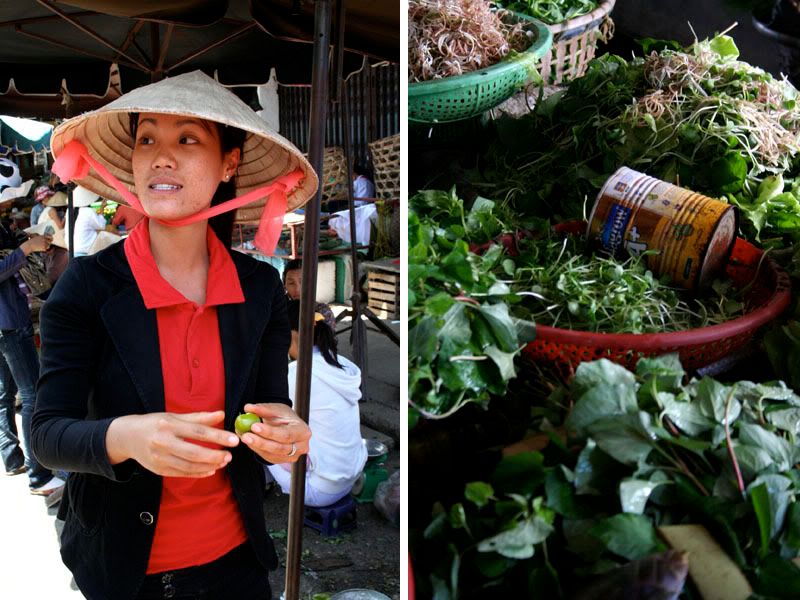
We met the other students at the Hai Cafe, in Hoi An's old town. There, we got the first sign of a major difference between other cooking classes we'd taken-- the number of students was much larger. As we waited for the class to depart, more and more people came, and the class quickly grew to around 20 people- massive, compared to the five person average we'd had at other cooking classes. Thankfully, multiple guides appeared, and we broke up into small six-person groups.
Like most cooking classes, this one began with a market tour. Hoi An has a great central market, and the tour took great advantage of it-- introducing us to local flavors and herbs, strange vegetables and fruits, and interesting utensils that revealed local cooking techniques. Our guide was great- informative, engaging, and funny.
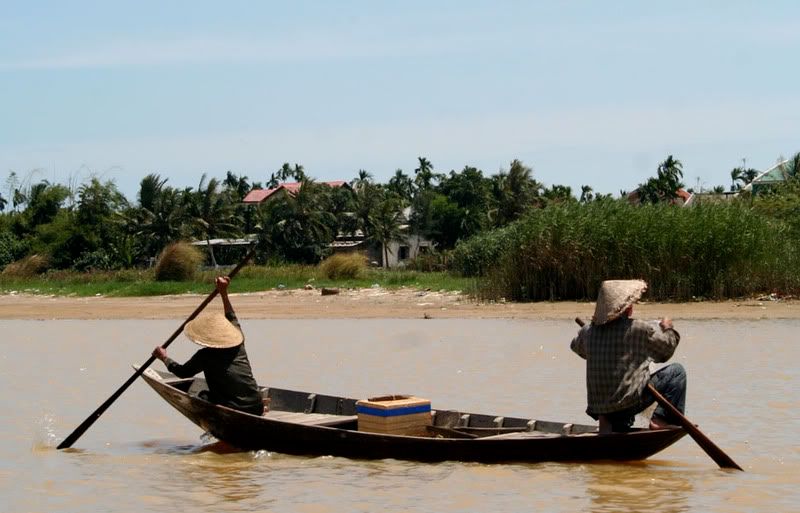
She dropped us at the pier, where we boarded the boat to the cooking school. The trip was a definite highlight- a twenty minute float down the muddy river, past fishing traps and under arching palm leavess. Along the way, an old woman in a canoe, smiling between chomps of betel-nut, motioned our boat over. When we got close, she lassoed us, and hitched a lift off us.
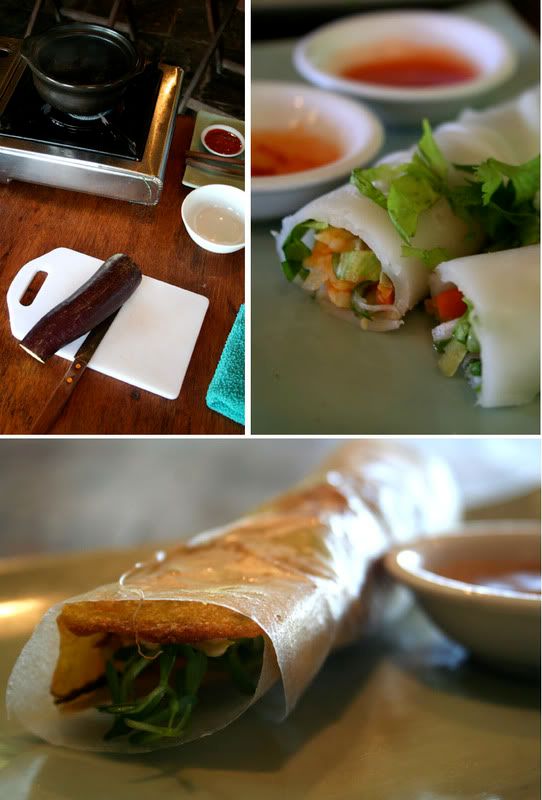
We arrived at Red Bridge Restaurant, easily the most attractive setting for any cooking class we'd taken. Set right on the river, the kitchen was surrounded by lush tropical greenery, and decorated with bamboo blinds and white silk lanterns. After a quick tour of the herb gardens, our guides wished us a good class, and departed-- and we were left to merge the mini groups into one massive class.
We took seats in classroom like rows of chairs, and after a twenty minute wait, our cooking teacher emerged. He seemed tired, bored, and a little disinterested in the class-- fair enough, if he has to teach multiple 20 person classes a week. There were some weak jokes in his script, but he seemed so lifeless that they passed by without him changing the tone or speed of his reading. He proceeded to make the first dish, the seafood salad, completely on his own-- simply showing it to us. The dish was whisked away by one of the many assistants, and he proceeded on to the claypot eggplant. For this, we got our first taste of 'cooking'- we were shown to our stations, told to slice the eggplants, plop it in the boiling water, and add a cup of tomato sauce. We then returned to our seats, and the claypot eggplant was taken away by the staff. It proceeded basically like that for the rest of the class- we made fresh rice paper, but not the filling for the rolls; we quickly made the banh xeo, being prodded to hurry up the whole time by roaming cooking assistants. If any students made a mistake (which I, of course, made several) the assistants became vaguely annoyed, and either corrected them sharply, or simply did it themselves.
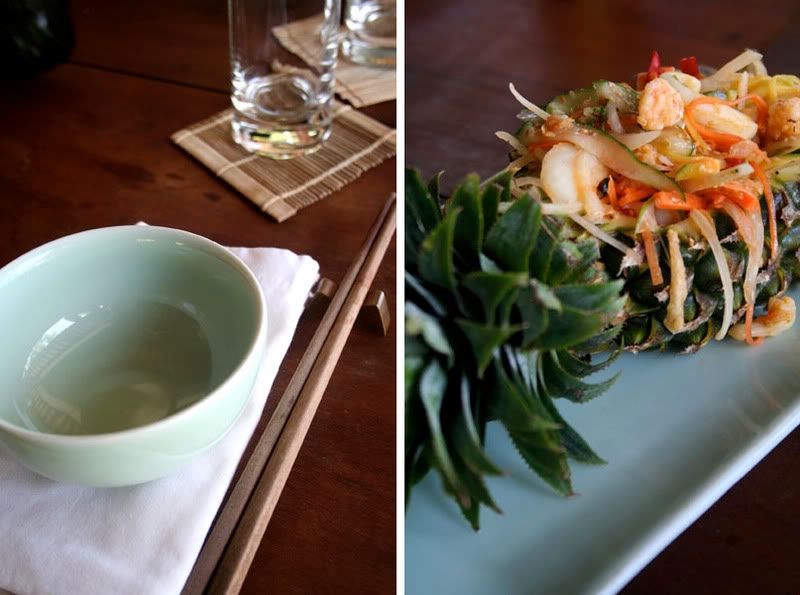
Having spent about an hour watching a cooking demonstration, and maybe fifteen minutes actually cooking, we were lead to the dining room for a late lunch. The lunch, at least, was fantastic. The seafood salad was tangy and spicy, the claypot eggplant rich and flavorful (made with, I suspect, more than just a cup of tomato sauce), and an extra dish, steamed ocean fish, was fantastic.
So now, some thoughts.
Good: The class was well-organized, and aside from the way too long wait for our chef to show up, ran smoothly. The market tour was informative, the boat trip was enjoyable, and the lunch was spectacular.
Bad: Maybe I'm hard to please, but the class was run
too smoothly. It felt a little like a Theme Park of cookery-- fair enough, this is Hoi An, after all. But there was nothing personal, no individual character to much of it. We were rushed along an assembly line, getting to slice a vegetable here, and roll a salad roll there. Our cooking instructor was clearly bored, and it affected the atmosphere of the class. And really, aside from the discussion on the market tour, we learned nothing about Vietnamese cuisine and culture, or about what makes the cooking of Hoi An and Central Vietnam unique.
Verdict: Would I recommend it? It's complicated. As Bordeaux pointed out, this was the least enjoyable cooking class we've taken. At all of the others, we enjoyed a connection with our instructor and felt like we really got to try our hands at making some local dishes. At the best classes- like Hidden Hanoi- we actually learned about the culture through learning about their cooking.
And yet, I get the sense that almost everyone at the class had a great time. It was, all in all, a pretty fun day-- there were certainly more activities than at any of the other cooking classes I've taken. And we got an outstanding lunch in an incredible setting. And the price- $18- means that it was actually incredibly inexpensive.
So I think for a visitor to Hoi An looking for a fun day out, it's actually a great activity. It gets you beyond the old town to see some of the surrounding countryside, and you get a great lunch out of it. But for someone really interested in cooking, and in the cuisine of Central Vietnam- I think it's kind of disappointing. The full day class, I read later, is done in smaller groups, and is more geared towards this category of student- but it's a shame that the menu doesn't focus more on regional dishes, or offer some variety or choice. Numerous restaurants throughout Hoi An offer private cooking classes, where you have the choice of what to make-- and that may be the better option.
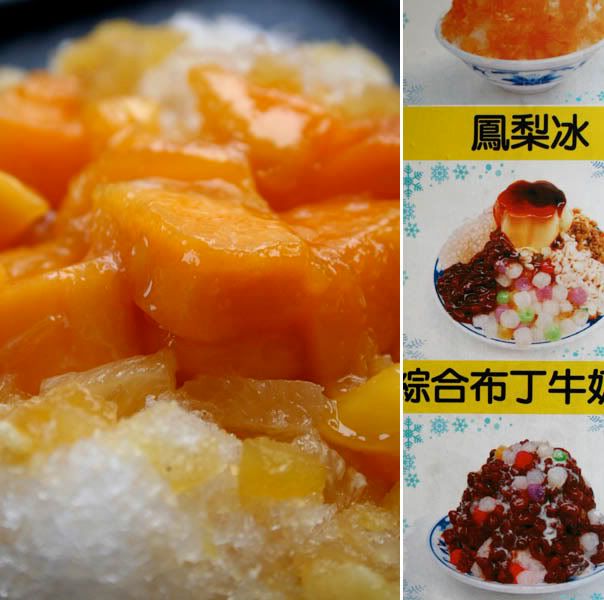 Of all the Taiwan Treats I've cataloged, likely none are as distinctly Taiwanese as shaved ice. It's designed with Taiwan's climate in mind, as it's the perfect refreshment for a steamy-scorching subtropical summer. It can feature a variety of toppings that evoke the cuisines and produce of the island, from syrupy mango to starchy-sweet redbean and taro. And perhaps more than any other dessert, it shows off the playfully inventive nature that makes Taiwan so unique.
Of all the Taiwan Treats I've cataloged, likely none are as distinctly Taiwanese as shaved ice. It's designed with Taiwan's climate in mind, as it's the perfect refreshment for a steamy-scorching subtropical summer. It can feature a variety of toppings that evoke the cuisines and produce of the island, from syrupy mango to starchy-sweet redbean and taro. And perhaps more than any other dessert, it shows off the playfully inventive nature that makes Taiwan so unique.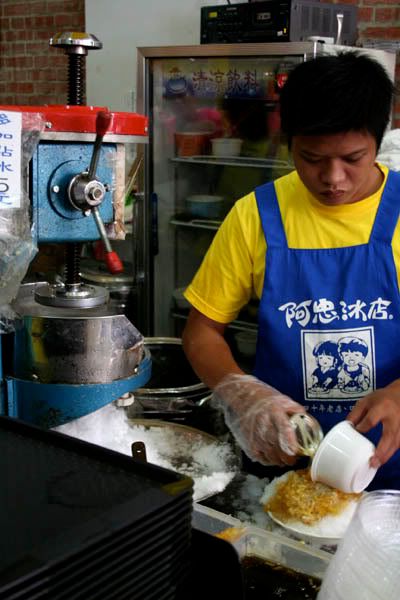 First, a layer of shaved or crushed ice is taken from a larger cube. Sometimes it is served 'fresh', elsewhere it is soaked in a sweet syrup. This is heaped generously into a vessel, which can range from a modest cup, to a family-sized platter. Next, toppings are heaped on- one topping, two toppings, or maybe nearly a dozen, depending on the creativity of the vendor.
First, a layer of shaved or crushed ice is taken from a larger cube. Sometimes it is served 'fresh', elsewhere it is soaked in a sweet syrup. This is heaped generously into a vessel, which can range from a modest cup, to a family-sized platter. Next, toppings are heaped on- one topping, two toppings, or maybe nearly a dozen, depending on the creativity of the vendor.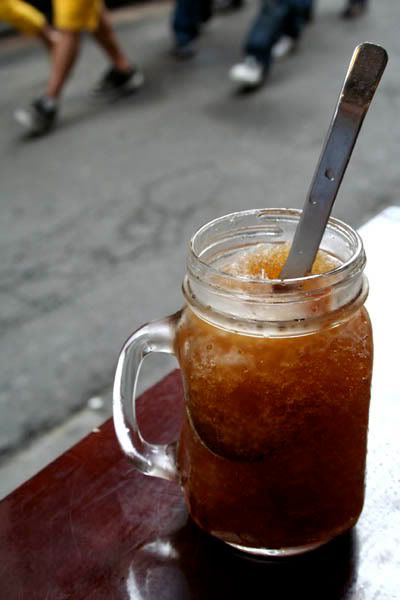 I had read about shaved ice before coming to Taiwan, and I was intrigued to try it. So on our first afternoon in Taipei, Bordeaux and I found a rather modern shop that specialized in it. With stark white walls, glowing red lanterns, and an open hi-tech kitchen, it hardly resembled the simple shaved ice shops described in out guidebook. We later found out that this was a national chain, with locations all over Taiwan. The shaved ice we sampled that afternoon was 'pineapple ice', which sounded tempting, and was described on the menu as being the most traditionally Taiwanese. We took the glass mug out onto the porch, and tasted it. Though the flavor was pleasant, the pineapple flavor was way too sweet, and the syrupy consistency was terrible for the tropical heat of late afternoon. I left the shop feeling more sickened than refreshed. We tried another Meet Fresh a week later, and sampled an entirely different concoction- shaved ice with red bean, taro, and lentils. Though the wholesome starchy flavor was delicious, the ice was again way too syrupy and filling.
I had read about shaved ice before coming to Taiwan, and I was intrigued to try it. So on our first afternoon in Taipei, Bordeaux and I found a rather modern shop that specialized in it. With stark white walls, glowing red lanterns, and an open hi-tech kitchen, it hardly resembled the simple shaved ice shops described in out guidebook. We later found out that this was a national chain, with locations all over Taiwan. The shaved ice we sampled that afternoon was 'pineapple ice', which sounded tempting, and was described on the menu as being the most traditionally Taiwanese. We took the glass mug out onto the porch, and tasted it. Though the flavor was pleasant, the pineapple flavor was way too sweet, and the syrupy consistency was terrible for the tropical heat of late afternoon. I left the shop feeling more sickened than refreshed. We tried another Meet Fresh a week later, and sampled an entirely different concoction- shaved ice with red bean, taro, and lentils. Though the wholesome starchy flavor was delicious, the ice was again way too syrupy and filling.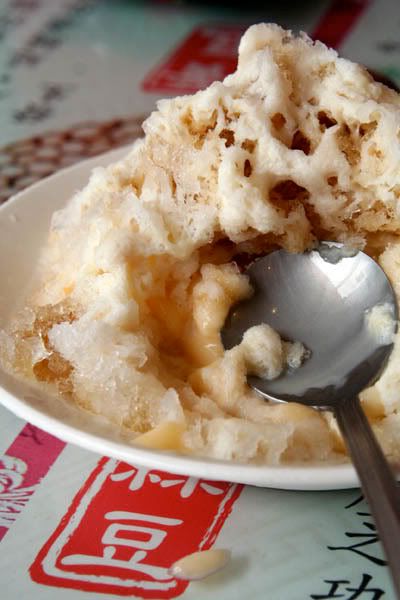 Thankfully, I wasn't put off from trying it all together. We searched out a different shaved ice shop, and tried a new dish- pudding shaved ice. As I've written before, pudding in Taiwan is more like a flan, or a caramel custard. The pudding was placed in the bowl first, and it was topped in a mountain of ice and sweetened condensed milk. Against all expectations, this dish was actually less filling and far more refreshing than the two we'd tried before. The non-flavored ice nicely countered the sweetness of the pudding, instead bringing out its rich milkyness.
Thankfully, I wasn't put off from trying it all together. We searched out a different shaved ice shop, and tried a new dish- pudding shaved ice. As I've written before, pudding in Taiwan is more like a flan, or a caramel custard. The pudding was placed in the bowl first, and it was topped in a mountain of ice and sweetened condensed milk. Against all expectations, this dish was actually less filling and far more refreshing than the two we'd tried before. The non-flavored ice nicely countered the sweetness of the pudding, instead bringing out its rich milkyness.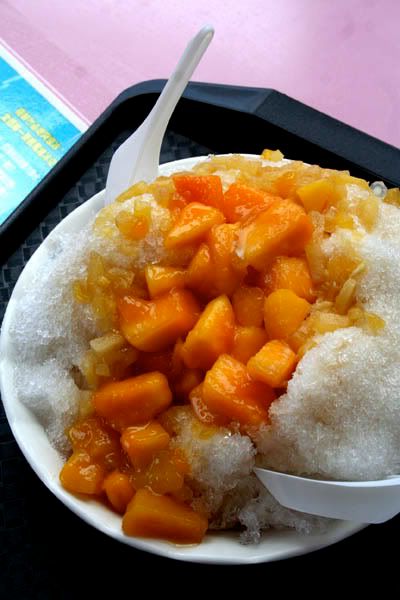 But perhaps the best bowl we've had came after out lunch at Hsinchu's Eating Temple. In a neon-painted four story tower next to the temple, we ordered a bowl of mango shaved ice. The ice was crushed into a feathery texture, and spooned over a bowl of fresh mango and pineapple. The tropical fruits mixed perfectly with the finely shaved ice, making the ideal tropical treat for a humid tropical afternoon.
But perhaps the best bowl we've had came after out lunch at Hsinchu's Eating Temple. In a neon-painted four story tower next to the temple, we ordered a bowl of mango shaved ice. The ice was crushed into a feathery texture, and spooned over a bowl of fresh mango and pineapple. The tropical fruits mixed perfectly with the finely shaved ice, making the ideal tropical treat for a humid tropical afternoon.
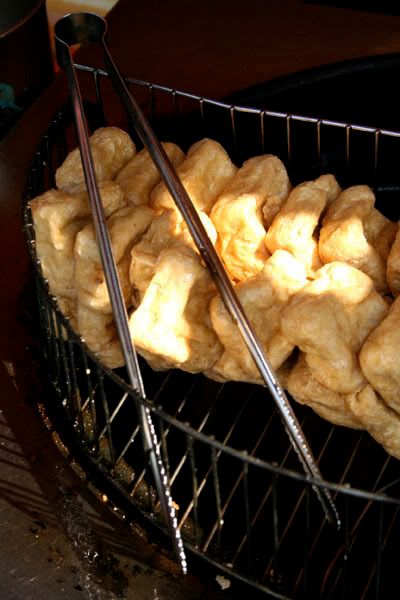 Though Taiwan has countless local specialties and hundreds of unique delicacies, few dishes have are as iconic of the island as one: chou dofu, stinky tofu. If you’ve ever been in the same neighborhood as a stinky tofu vendor, you’ll need no explanation of its name- its aroma (for which there is no polite description) is nearly strong enough to knock a passer-by off his scooter.
Though Taiwan has countless local specialties and hundreds of unique delicacies, few dishes have are as iconic of the island as one: chou dofu, stinky tofu. If you’ve ever been in the same neighborhood as a stinky tofu vendor, you’ll need no explanation of its name- its aroma (for which there is no polite description) is nearly strong enough to knock a passer-by off his scooter.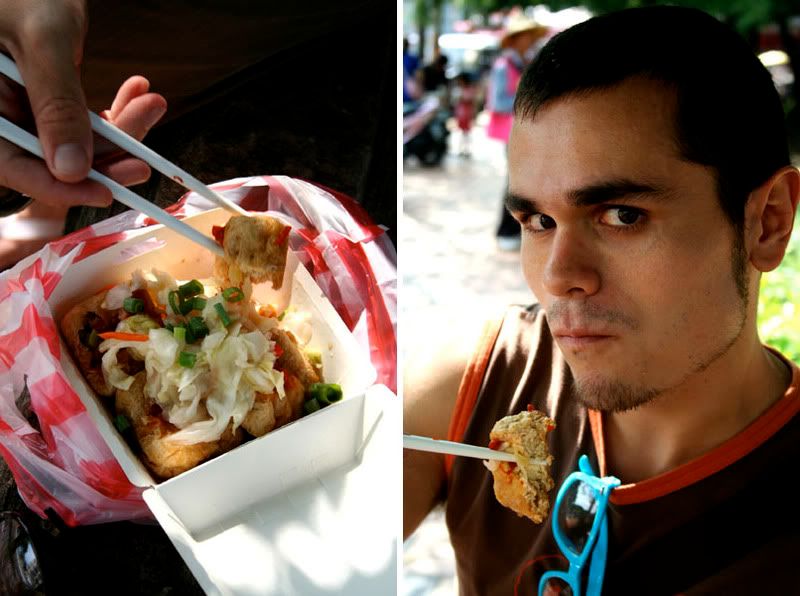 Though the stink failed to tempt me, I was curious to try the dish. I don’t seek out food simply because it sounds strange or unusual- but I was curious to see how stinky tofu could be so popular despite its smell. In search of the food, Bordeaux and I visited a popular weekend market. We strolled among other food stands and carnival games, brushing past the inviting aroma of grilled squid and sizzling scallion pancakes, in search of a less pleasant stench. Eventually, we caught the smell- quick, disgusting, and gone. We backtracked, but failed to find the source. We circled around, made enquiries, and finally found the stinky tofu. We ordered one, and took it away to try. Piled with pickled vegetables and drizzled with a spicy sauce, it almost looked tempting. But it only took one bite to dispel me of that feeling- it tasted much like it smelled, a mature barnyard flavor that didn’t compel me to complete the dish.
Though the stink failed to tempt me, I was curious to try the dish. I don’t seek out food simply because it sounds strange or unusual- but I was curious to see how stinky tofu could be so popular despite its smell. In search of the food, Bordeaux and I visited a popular weekend market. We strolled among other food stands and carnival games, brushing past the inviting aroma of grilled squid and sizzling scallion pancakes, in search of a less pleasant stench. Eventually, we caught the smell- quick, disgusting, and gone. We backtracked, but failed to find the source. We circled around, made enquiries, and finally found the stinky tofu. We ordered one, and took it away to try. Piled with pickled vegetables and drizzled with a spicy sauce, it almost looked tempting. But it only took one bite to dispel me of that feeling- it tasted much like it smelled, a mature barnyard flavor that didn’t compel me to complete the dish.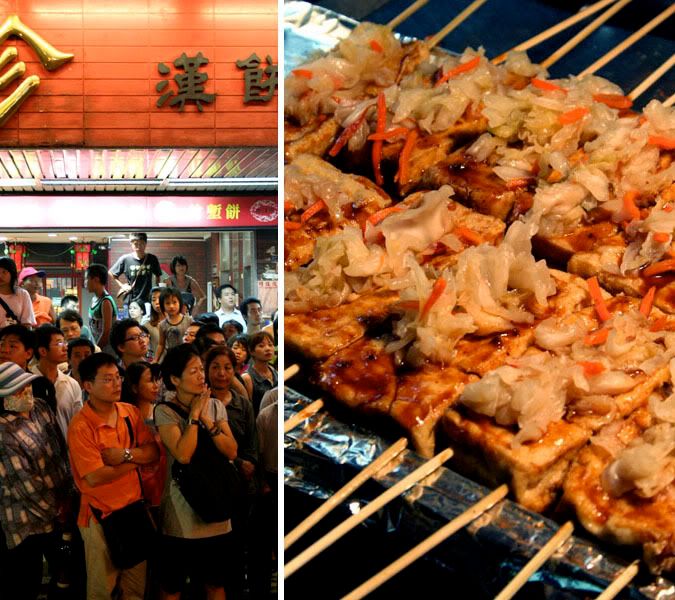 Thankfully, I got the chance to try it again. At a raucous ghost month parade, I caught the familiar stench among the singed scent of fireworks. The smell grew stronger, almost overpowering, as I approached the stand. I ordered a skewer, and took a bite. Amazingly, though the smell was considerably worse, the flavor was considerably better. The tofu was firm, flavorful, and nicely spiced with the pickled vegetables and chili. It was much better than the first, proving that even the stinkiest foods deserve a second try.
Thankfully, I got the chance to try it again. At a raucous ghost month parade, I caught the familiar stench among the singed scent of fireworks. The smell grew stronger, almost overpowering, as I approached the stand. I ordered a skewer, and took a bite. Amazingly, though the smell was considerably worse, the flavor was considerably better. The tofu was firm, flavorful, and nicely spiced with the pickled vegetables and chili. It was much better than the first, proving that even the stinkiest foods deserve a second try.
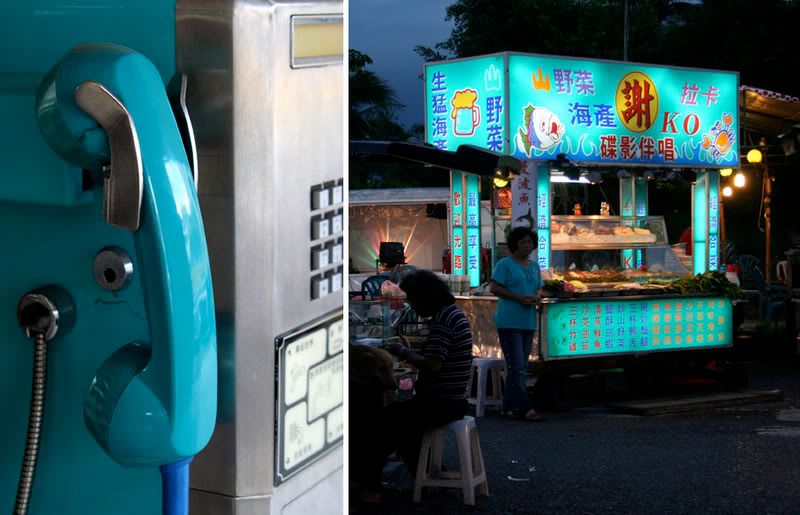 Teal is not a color you encounter often. Too clinical to be comforting, too out-dated to be hip. But strangely, it seems almost to be the national color of Taiwan. It appeared in plastic phones, on pharmacy walls, and faded wooden doors. Yet odd as it is, it works. It paired surprisingly well with ocher bricks and vibrant red banners. And almost to assure us of its place in the Taiwanese color spectrum, it flows vibrantly through the halls of the new airport terminal.
Teal is not a color you encounter often. Too clinical to be comforting, too out-dated to be hip. But strangely, it seems almost to be the national color of Taiwan. It appeared in plastic phones, on pharmacy walls, and faded wooden doors. Yet odd as it is, it works. It paired surprisingly well with ocher bricks and vibrant red banners. And almost to assure us of its place in the Taiwanese color spectrum, it flows vibrantly through the halls of the new airport terminal.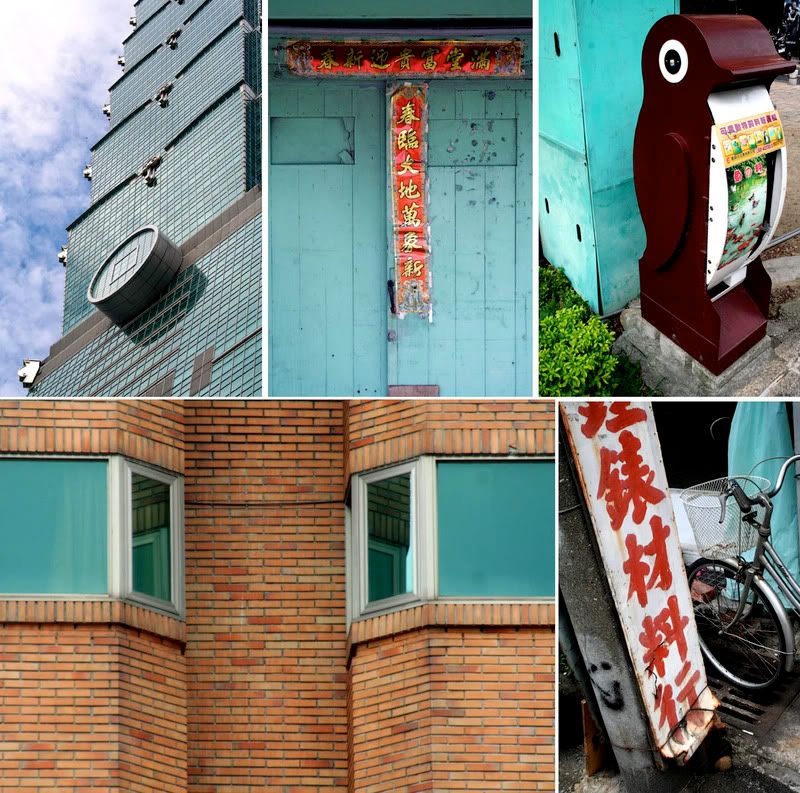
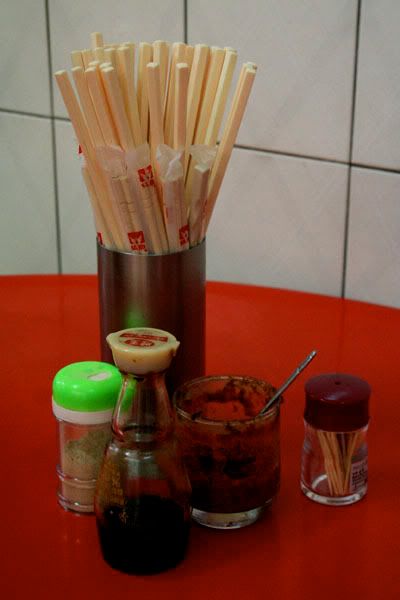 If you mention that you're visiting another town in Taiwan, you're more than likely to be told what kind of food you should eat when you get there. Despite its small size (or perhaps because of it), every town in Taiwan seems to have a local specialty, a 'famous food' that all visitors are obliged to try. Taiwan has a highly developed internal tourism infrastructure (unlike its international tourism infrastructure, which I'll discuss later), and one of the highlights for most Taiwanese travelers is sampling all the famous dishes of the island. People will pile into a car to try stinky green-bean curd, or board a bus to sample a rice lunch box. After a month and a half living in Hsinchu, Bordeaux and I decided to join these culinary travelers. We set out on a railroad trip around the entire island, and top of our itinerary was trying Taiwan's famous dishes.
If you mention that you're visiting another town in Taiwan, you're more than likely to be told what kind of food you should eat when you get there. Despite its small size (or perhaps because of it), every town in Taiwan seems to have a local specialty, a 'famous food' that all visitors are obliged to try. Taiwan has a highly developed internal tourism infrastructure (unlike its international tourism infrastructure, which I'll discuss later), and one of the highlights for most Taiwanese travelers is sampling all the famous dishes of the island. People will pile into a car to try stinky green-bean curd, or board a bus to sample a rice lunch box. After a month and a half living in Hsinchu, Bordeaux and I decided to join these culinary travelers. We set out on a railroad trip around the entire island, and top of our itinerary was trying Taiwan's famous dishes.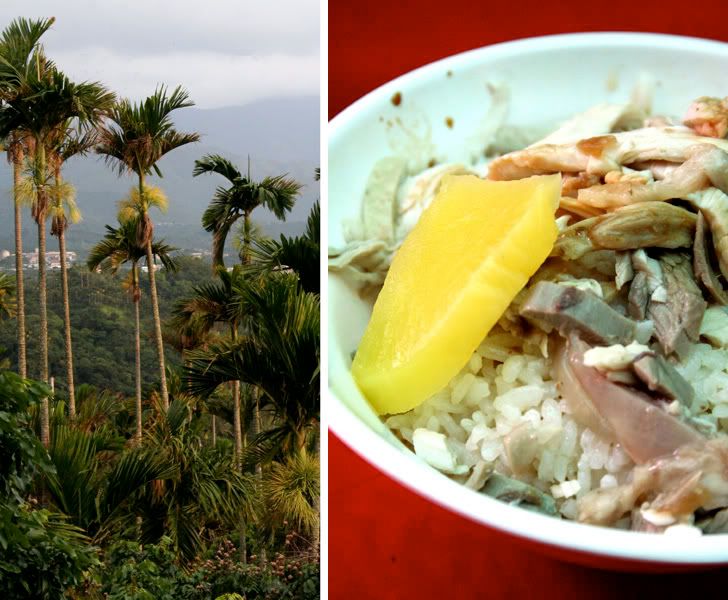 The town of Chaiyi sits at the line where Taiwan dips into the tropics. Yet it's special dish hardly evokes its torpid climate or lush landscape- turkey rice. It's nearly as simple as it sounds, strips of tender turkey eaten over a bed of white rice, and paired with a chunk of pickled turnip. It has a wholesome and hearty quality, reminiscent of a plate of Thanksgiving left-overs.
The town of Chaiyi sits at the line where Taiwan dips into the tropics. Yet it's special dish hardly evokes its torpid climate or lush landscape- turkey rice. It's nearly as simple as it sounds, strips of tender turkey eaten over a bed of white rice, and paired with a chunk of pickled turnip. It has a wholesome and hearty quality, reminiscent of a plate of Thanksgiving left-overs.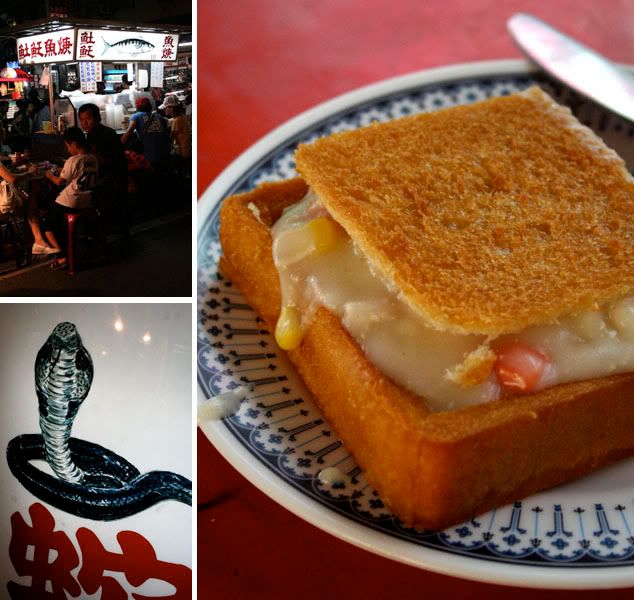 Our next stop was Kaoshuing, Taiwan's largest metropolis, and an attractive oceanfront city. After browsing in hip shopping streets, we headed over to the city's largest nightmarket. There we sampled a regional specialty, more associated with nearby Tainan than Kaoshiung. Named 'coffin bread' in English, it's a thick slice of texas toast fried, cut open, and filled with a creamy seafood chowder. Looking at it for the first time, I remarked to Bordeaux that it was the strangest food we'd eaten in Taiwan. He rightly pointed out that it's also the most American. It is in fact a remnant of American naval presence in southern Taiwan, and almost seems like a dish that could be served at an American seaside diner.
Our next stop was Kaoshuing, Taiwan's largest metropolis, and an attractive oceanfront city. After browsing in hip shopping streets, we headed over to the city's largest nightmarket. There we sampled a regional specialty, more associated with nearby Tainan than Kaoshiung. Named 'coffin bread' in English, it's a thick slice of texas toast fried, cut open, and filled with a creamy seafood chowder. Looking at it for the first time, I remarked to Bordeaux that it was the strangest food we'd eaten in Taiwan. He rightly pointed out that it's also the most American. It is in fact a remnant of American naval presence in southern Taiwan, and almost seems like a dish that could be served at an American seaside diner.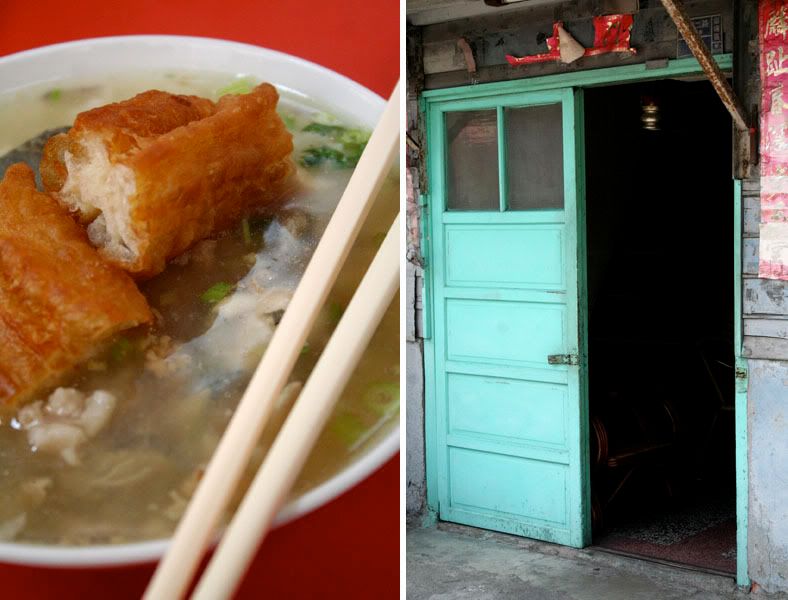 The next morning, we traveled across the Love River to the old area of town for another specialty, milk fish congee. It was a watery rice soup that contained not just milkfish, but also oysters, clams, and other fresh seafood. Eaten with chunks of long chinese donuts, it made a complexly nuanced breakfast- at times sweet and buttery, alternately fresh and salty.
The next morning, we traveled across the Love River to the old area of town for another specialty, milk fish congee. It was a watery rice soup that contained not just milkfish, but also oysters, clams, and other fresh seafood. Eaten with chunks of long chinese donuts, it made a complexly nuanced breakfast- at times sweet and buttery, alternately fresh and salty.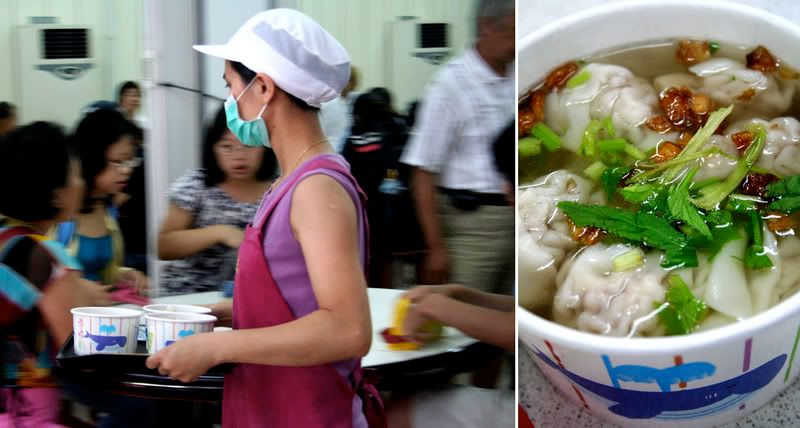 Arriving for lunch at a famed restaurant in Hualien, we for the first time found a line of diners. We briefly wondered if we should reconsider- but eventually gave in and joined the queue. The line moved quickly, and we were soon ushered to a shared table in a cavernous dining hall. The wait for our dish gave us time to consider- is being famous a good thing? Are we going to discover that this dish rests on its fame, nothing else? Then the paper dishes of bianshji were placed in front of us. The light broth was browned with charred garlic, almost giving it the flavor of Vietnamese pho. But it was set apart by the plump dumplings that floated in it- filled with an incredible mixture of ground pork and shrimp. Looking around the room, we saw that some tables had wisely ordered an extra bowl, so that each member of their party could savor one more dumpling.
Arriving for lunch at a famed restaurant in Hualien, we for the first time found a line of diners. We briefly wondered if we should reconsider- but eventually gave in and joined the queue. The line moved quickly, and we were soon ushered to a shared table in a cavernous dining hall. The wait for our dish gave us time to consider- is being famous a good thing? Are we going to discover that this dish rests on its fame, nothing else? Then the paper dishes of bianshji were placed in front of us. The light broth was browned with charred garlic, almost giving it the flavor of Vietnamese pho. But it was set apart by the plump dumplings that floated in it- filled with an incredible mixture of ground pork and shrimp. Looking around the room, we saw that some tables had wisely ordered an extra bowl, so that each member of their party could savor one more dumpling.
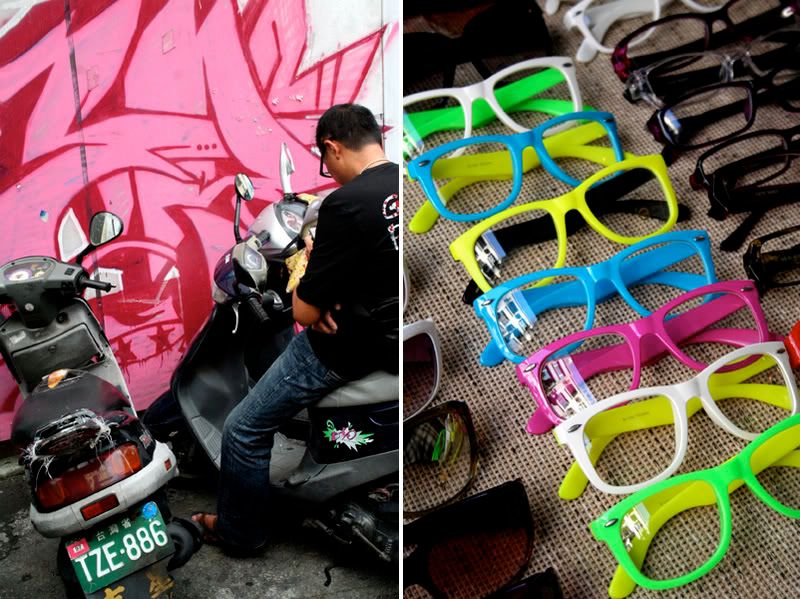 One of the most surprising things about Taiwan was finding that it had a teeming urban youth culture- and that culture had a color scheme. NEON. You'd glimpse it in downtown alleys, on electric-blue cargo shorts, and hot pink baseball caps. But it came out best at night, when the hues of the neon signs seemed to reflect in hip night market stands and blazing arcade parlors.
One of the most surprising things about Taiwan was finding that it had a teeming urban youth culture- and that culture had a color scheme. NEON. You'd glimpse it in downtown alleys, on electric-blue cargo shorts, and hot pink baseball caps. But it came out best at night, when the hues of the neon signs seemed to reflect in hip night market stands and blazing arcade parlors.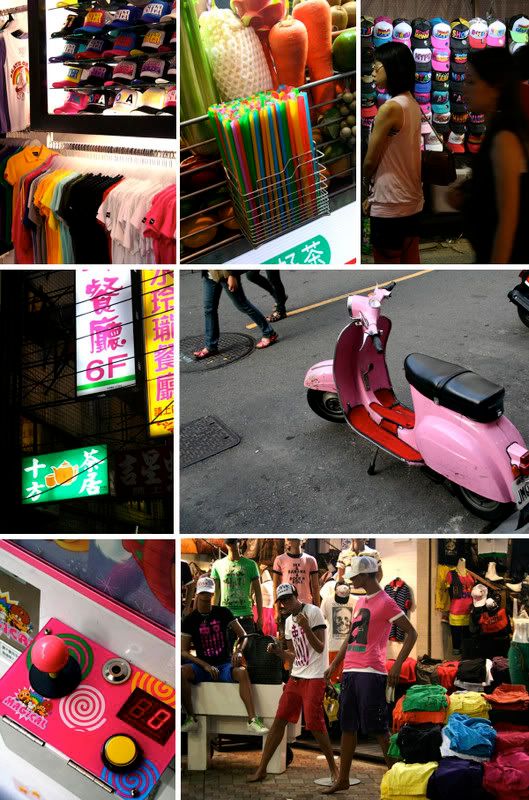
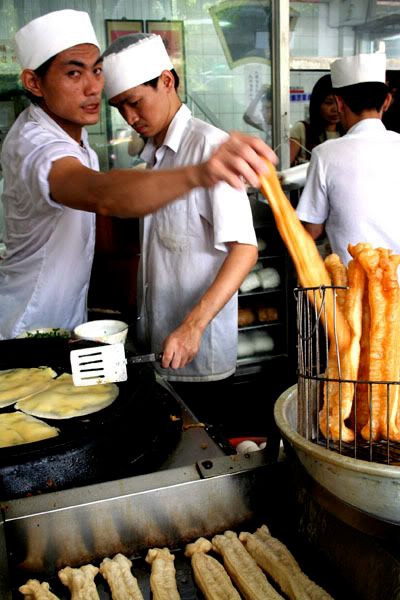 Does the ratio of staff to dining space say something about a restaurant? For though the dining area (and the kitchen, for that matter) at this Taipei breakfast shop were minuscule, the staff numbers were huge. There were at least nine people manning this formica canteen- one woman dishing out ladles of fresh soymilk into plastic cups and bowls, and eight or so men in white sweat-tinted uniforms working elbow-to-elbow in the kitchen. One tended the scallion omelettes, one handled steamed breads and foot-long doughnuts, another three unloaded the bamboo steamers, and the rest busied themselves in all of the other myriad tasks of preparing a delicious Taiwanese breakfast.
Does the ratio of staff to dining space say something about a restaurant? For though the dining area (and the kitchen, for that matter) at this Taipei breakfast shop were minuscule, the staff numbers were huge. There were at least nine people manning this formica canteen- one woman dishing out ladles of fresh soymilk into plastic cups and bowls, and eight or so men in white sweat-tinted uniforms working elbow-to-elbow in the kitchen. One tended the scallion omelettes, one handled steamed breads and foot-long doughnuts, another three unloaded the bamboo steamers, and the rest busied themselves in all of the other myriad tasks of preparing a delicious Taiwanese breakfast.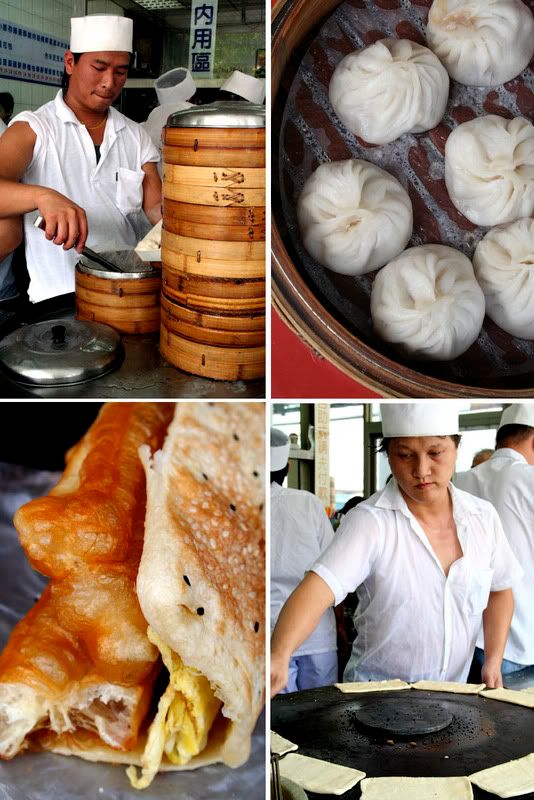 Of the three daily meals, the one I enjoyed most in Taiwan was breakfast. It was entirely because of incredible breakfast shops like the above, where I sampled delicious morning treats. I ate shaolingbao, soupy pork filled dumplings that dripped (ok, exploded) when I bit into them; danbing, tasty rolled egg pancakes filled with bacon, tuna, or cheese and spring onions; and scallion omelettes, eaten in thin sesame seed bread. And all, of course, eaten with a glass of fresh, chilled soymilk.
Of the three daily meals, the one I enjoyed most in Taiwan was breakfast. It was entirely because of incredible breakfast shops like the above, where I sampled delicious morning treats. I ate shaolingbao, soupy pork filled dumplings that dripped (ok, exploded) when I bit into them; danbing, tasty rolled egg pancakes filled with bacon, tuna, or cheese and spring onions; and scallion omelettes, eaten in thin sesame seed bread. And all, of course, eaten with a glass of fresh, chilled soymilk.
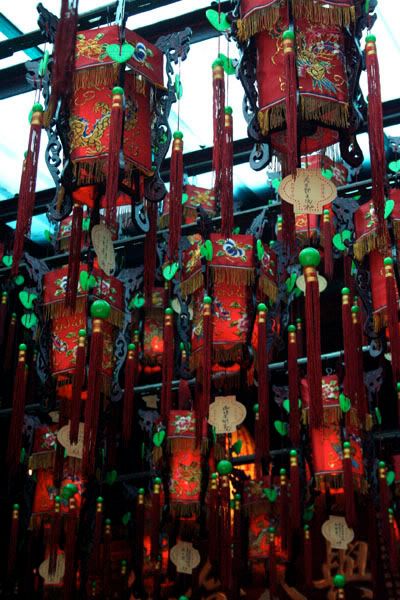 I should point out that despite appearances here at Primitive Culture, I'm not actually in Taiwan anymore- and haven't been, in fact, for several weeks. But several factors have kept my blogging stranded on the island- partly a busy transient schedule and irregular internet access, but mainly I think a surplus of material to write about. There were so many incredible places I went, delicious foods I ate, and strange drinks I tested that I still haven't been able to wrap up my coverage of Taiwan. But I really should get moving on- and I can always write about Taiwan in the future- so I'll finish up my coverage of Taiwan with two final dinners.
I should point out that despite appearances here at Primitive Culture, I'm not actually in Taiwan anymore- and haven't been, in fact, for several weeks. But several factors have kept my blogging stranded on the island- partly a busy transient schedule and irregular internet access, but mainly I think a surplus of material to write about. There were so many incredible places I went, delicious foods I ate, and strange drinks I tested that I still haven't been able to wrap up my coverage of Taiwan. But I really should get moving on- and I can always write about Taiwan in the future- so I'll finish up my coverage of Taiwan with two final dinners.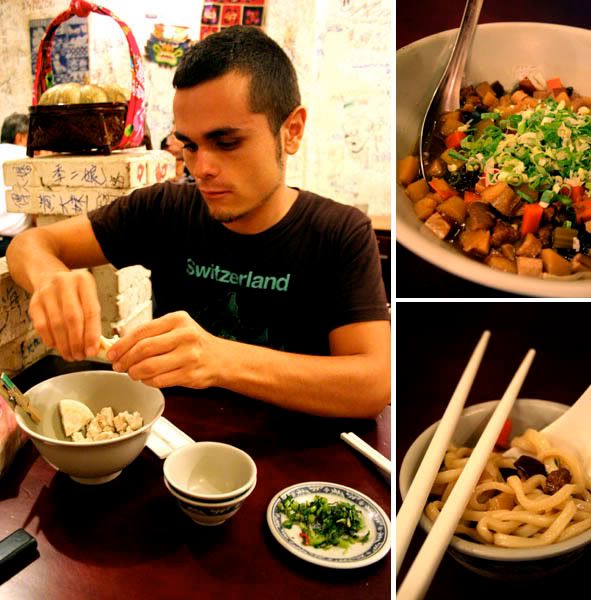 One of the pleasures of eating across Taiwan is that in addition to local Taiwanese specialties, you can sample from a broad range of Chinese cuisines. The main style of Chinese cooking in Taiwan is from the Fujian region, but Szechuan, Cantonese, Hakka, Beijing, and Shanghai style are also present. Additionally, one can search out more obscure regional styles as well. Before we even landed in Taiwan, Bordeaux and I read about a restaurant in Taipei that served Shanxi style cuisine. We put it on our 'must eat' list, but every time we visited Taiwan something kept us from dining there. Finally, on one of our last nights in the country, we actually made it.
One of the pleasures of eating across Taiwan is that in addition to local Taiwanese specialties, you can sample from a broad range of Chinese cuisines. The main style of Chinese cooking in Taiwan is from the Fujian region, but Szechuan, Cantonese, Hakka, Beijing, and Shanghai style are also present. Additionally, one can search out more obscure regional styles as well. Before we even landed in Taiwan, Bordeaux and I read about a restaurant in Taipei that served Shanxi style cuisine. We put it on our 'must eat' list, but every time we visited Taiwan something kept us from dining there. Finally, on one of our last nights in the country, we actually made it.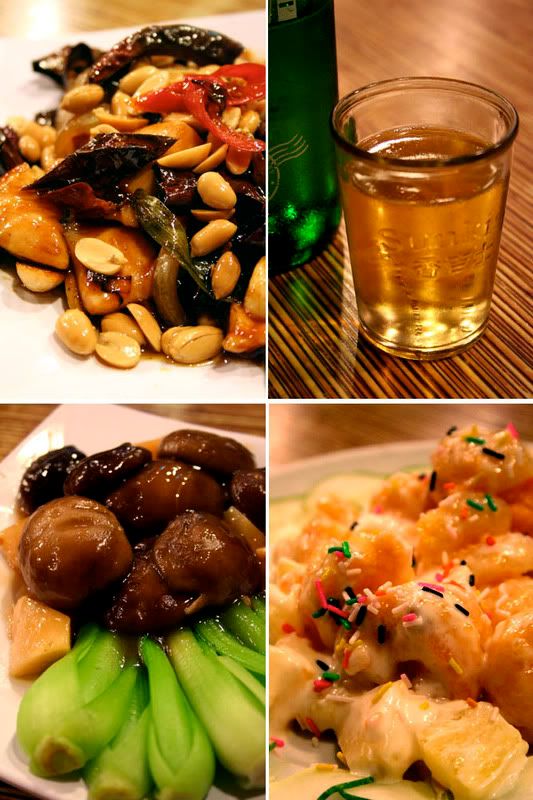 Our next farewell dinner was ordered after we returned to Hsinchu after a week spent travelling around the island. Bordeaux and I returned to one of our favorite restaurants, a place we knew simply as 'The Big Chief.' It got its name among the expat community several years ago, when the restaurant had displayed a carved Native American head over its entrance. The style and owners have since changed, the Native American head removed, but the name has lingered none the less. It's a large, two story restaurant, whose spacious haphazard interior is crowded with tables and banquet chairs. It's usually packed with families, the soundtrack for dinner a mix of boisterous conversation and playing children.
Our next farewell dinner was ordered after we returned to Hsinchu after a week spent travelling around the island. Bordeaux and I returned to one of our favorite restaurants, a place we knew simply as 'The Big Chief.' It got its name among the expat community several years ago, when the restaurant had displayed a carved Native American head over its entrance. The style and owners have since changed, the Native American head removed, but the name has lingered none the less. It's a large, two story restaurant, whose spacious haphazard interior is crowded with tables and banquet chairs. It's usually packed with families, the soundtrack for dinner a mix of boisterous conversation and playing children.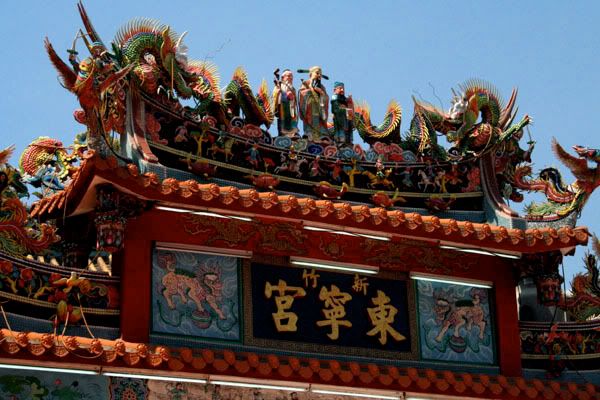 On our last day in Taiwan, Bordeaux and I zipped around the town of Hsinchu, taking our last glimpses of the island. We peeked into shrines, stopped at a tea stand, and admired a grand temple.
On our last day in Taiwan, Bordeaux and I zipped around the town of Hsinchu, taking our last glimpses of the island. We peeked into shrines, stopped at a tea stand, and admired a grand temple.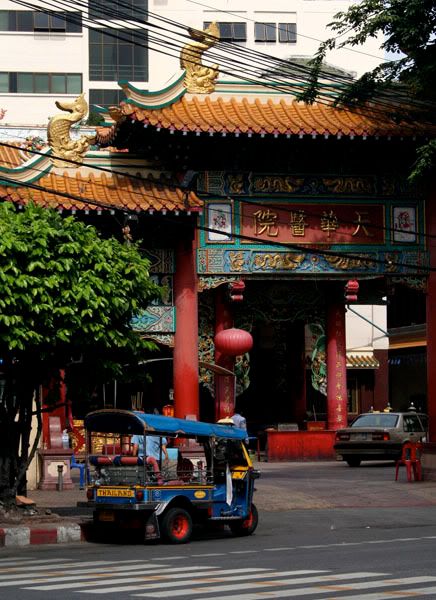 The morning after flying out of Taipei, we set out on city streets in search of breakfast. Having just come from Taiwan, certain sights seemed strikingly familiar. Yet as much as it looked like Taiwan, small details stood out, signaling that we weren't on the island anymore. Like the large Chinese temple, with the tuk-tuk parked out front...
The morning after flying out of Taipei, we set out on city streets in search of breakfast. Having just come from Taiwan, certain sights seemed strikingly familiar. Yet as much as it looked like Taiwan, small details stood out, signaling that we weren't on the island anymore. Like the large Chinese temple, with the tuk-tuk parked out front...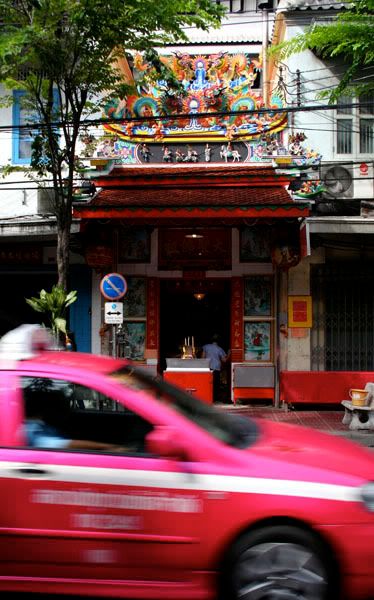 ...or like the Chinese shrine, with the pink taxi blasting past...
...or like the Chinese shrine, with the pink taxi blasting past... ...or the stone lion, with a garland of marigolds around his paws.
...or the stone lion, with a garland of marigolds around his paws.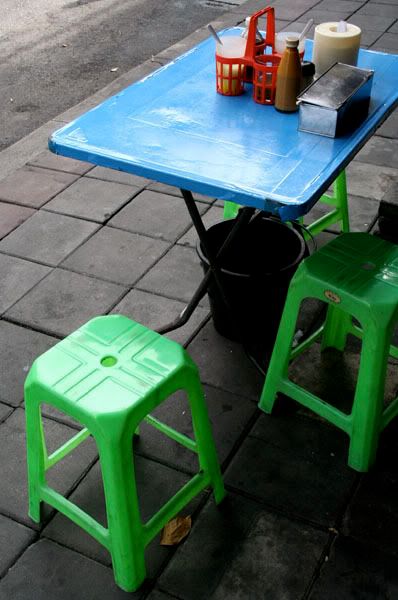 Clearly, we were back in Bangkok, a city that draws from so much of the world, yet has a style that is all its own.
Clearly, we were back in Bangkok, a city that draws from so much of the world, yet has a style that is all its own.
 After returning to Thailand, we headed north to Chiang Mai for a week of relaxation. It was a great chance to get back in touch with all of the things I love about Thailand- the tropical climate, the dazzling architecture, and the distinctive sense of style. And of course- the food.
After returning to Thailand, we headed north to Chiang Mai for a week of relaxation. It was a great chance to get back in touch with all of the things I love about Thailand- the tropical climate, the dazzling architecture, and the distinctive sense of style. And of course- the food.
 Last week, after a year of residency, Bordeaux and I packed up our belongings and handed in the keys at our Bangkok apartment. It was a change we'd been preparing for over the past few months, but it wasn't necessarily an easy one.
Last week, after a year of residency, Bordeaux and I packed up our belongings and handed in the keys at our Bangkok apartment. It was a change we'd been preparing for over the past few months, but it wasn't necessarily an easy one. Over our last week in the city, we revisited a few favorite spots. We had dimsum at Vanilla Garden, shopped for t-shirts at Chatuchak, and sipped chaa yen at the Erawan Tea Room (pictured above). It served as a reminder that we had it pretty sweet in Bangkok. The food in Bangkok is unquestionably among the best in the world; the shopping is amazing; and the city has such a personality and a distinctive sense style.
Over our last week in the city, we revisited a few favorite spots. We had dimsum at Vanilla Garden, shopped for t-shirts at Chatuchak, and sipped chaa yen at the Erawan Tea Room (pictured above). It served as a reminder that we had it pretty sweet in Bangkok. The food in Bangkok is unquestionably among the best in the world; the shopping is amazing; and the city has such a personality and a distinctive sense style. Perhaps saddest of all was leaving our apartment behind. We'd found a great little space that suited our needs perfectly, was close to the BTS and a friendly local wet market. It wasn't perfect in every way- the kitchen was practically nonexistent, and the karaoke across the street was a pain- but it was our first home together, and we were both very comfortable there. We've packed up our favorite things (the lamp above, included) and shipped them on- so hopefully they can serve us where-ever we next call home.
Perhaps saddest of all was leaving our apartment behind. We'd found a great little space that suited our needs perfectly, was close to the BTS and a friendly local wet market. It wasn't perfect in every way- the kitchen was practically nonexistent, and the karaoke across the street was a pain- but it was our first home together, and we were both very comfortable there. We've packed up our favorite things (the lamp above, included) and shipped them on- so hopefully they can serve us where-ever we next call home. For the next few months we'll be traveling nonstop- and while I'm excited about seeing new places and searching out new foods and styles, I am rather sad about what I'm leaving behind. Though there were certain things I didn't like about Bangkok- the pollution, namely- I didn't leave the city glad to be rid of it. The past year has been incredible, and I only hope I can take some of what I've learned and experienced with me.
For the next few months we'll be traveling nonstop- and while I'm excited about seeing new places and searching out new foods and styles, I am rather sad about what I'm leaving behind. Though there were certain things I didn't like about Bangkok- the pollution, namely- I didn't leave the city glad to be rid of it. The past year has been incredible, and I only hope I can take some of what I've learned and experienced with me.
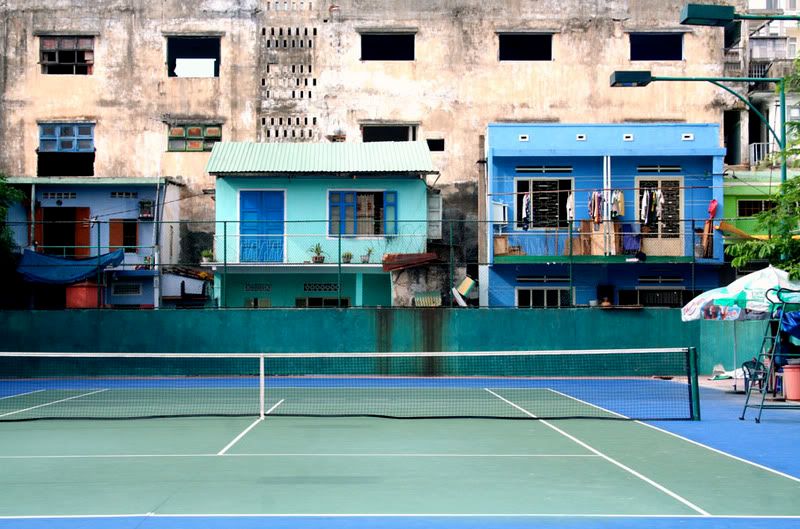 An hour and a half after leaving Bangkok's Suvarnabhumi Airport, our tiny plane touched in Vietnam. We arrived in Danang, our gateway to central Vietnam, and the city where we would begin the next phase of our travels.
An hour and a half after leaving Bangkok's Suvarnabhumi Airport, our tiny plane touched in Vietnam. We arrived in Danang, our gateway to central Vietnam, and the city where we would begin the next phase of our travels.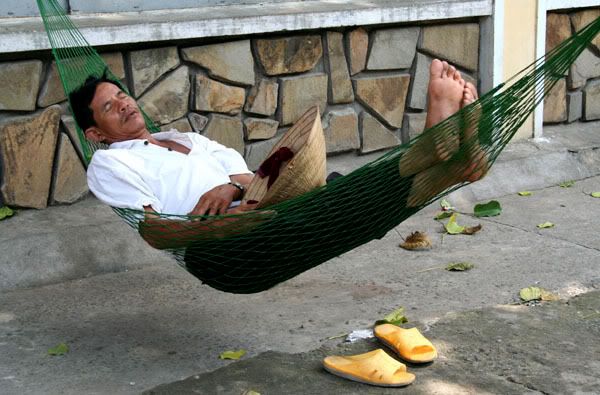 Though it's Vietnam's fourth largest city, the leafy avenues move at a sluggish, leisurely pace. Since Bordeaux and I had previously spent most of our time in Hanoi and Saigon, it was strange to see a Vietnamese city that wasn't constantly swirling with activity.
Though it's Vietnam's fourth largest city, the leafy avenues move at a sluggish, leisurely pace. Since Bordeaux and I had previously spent most of our time in Hanoi and Saigon, it was strange to see a Vietnamese city that wasn't constantly swirling with activity.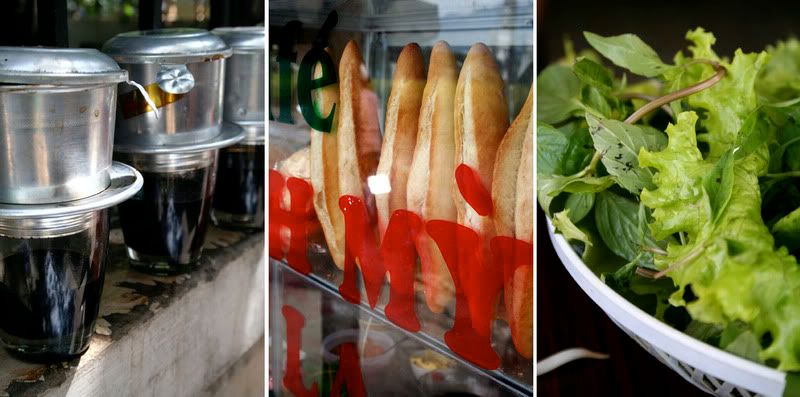 Thankfully, even though we were somewhere new, there were a few comfortingly familiar sights (and flavors) to remind us of why we'd come. More on that coming soon, of course...
Thankfully, even though we were somewhere new, there were a few comfortingly familiar sights (and flavors) to remind us of why we'd come. More on that coming soon, of course...
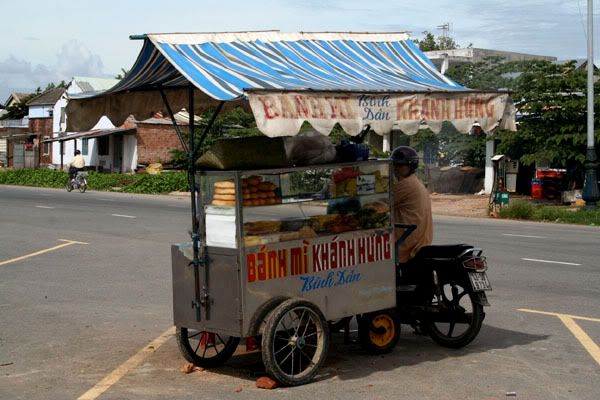 Beachside banh mi stand at Danang's China Beach. I don't think drive-up was ever this good at home...
Beachside banh mi stand at Danang's China Beach. I don't think drive-up was ever this good at home...
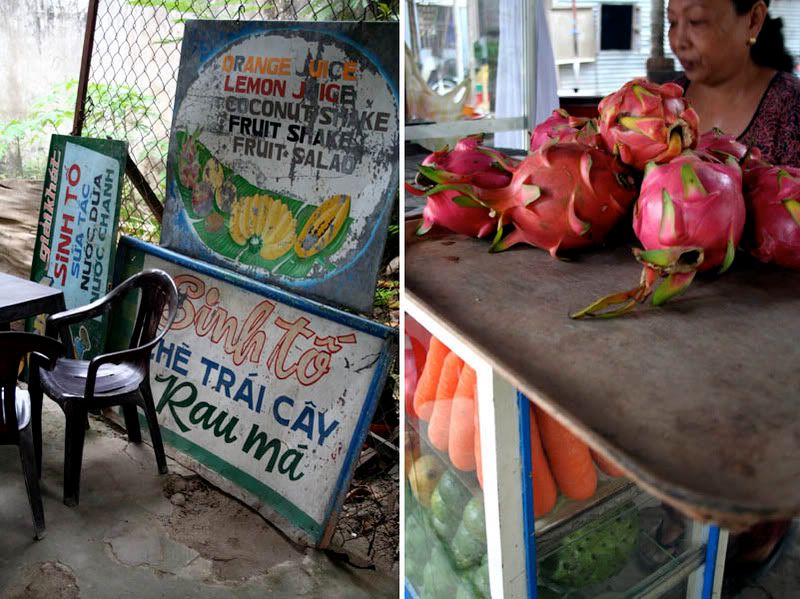 The avenues of Vietnam are dotted with shops and stands offering an incredible variety of sweets, from chewy mung bean parcels, to creamy ice creams, to buttery pastries, to colorful glasses of che'. As plentiful as the options are, however, nothing can compete with sinh to- the simple fruit and milk shake.
The avenues of Vietnam are dotted with shops and stands offering an incredible variety of sweets, from chewy mung bean parcels, to creamy ice creams, to buttery pastries, to colorful glasses of che'. As plentiful as the options are, however, nothing can compete with sinh to- the simple fruit and milk shake.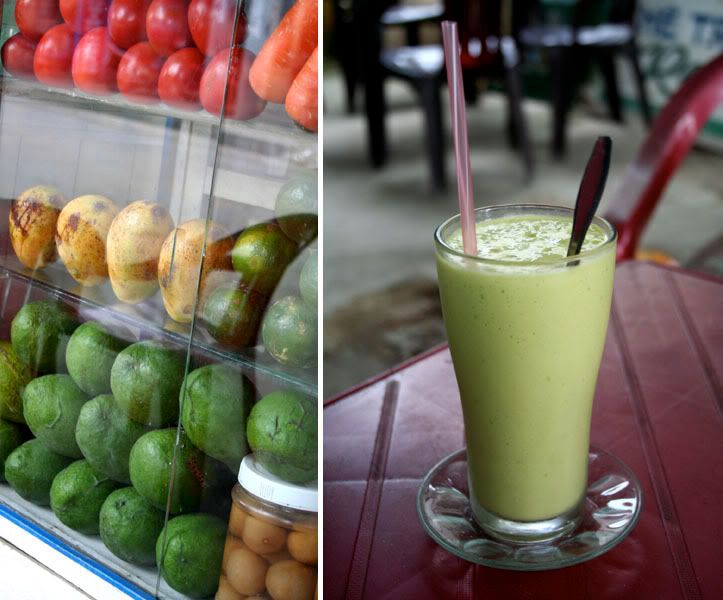 It's hard to choose a favorite- dragonfruit is refreshing, and ripe mango is pretty hard to beat- but lately I'm really fond of sinh to bo, avocado shakes. I first tried a variant in Taiwan, which was made with creme caramel pudding. Though the Vietnamese version is sans pudding, it's still relatively sweet, as its often made with condensed milk. When the balance is right though, the earthy flavor of the avo melts through, lending an offbeat nuance to the rich creamy shake.
It's hard to choose a favorite- dragonfruit is refreshing, and ripe mango is pretty hard to beat- but lately I'm really fond of sinh to bo, avocado shakes. I first tried a variant in Taiwan, which was made with creme caramel pudding. Though the Vietnamese version is sans pudding, it's still relatively sweet, as its often made with condensed milk. When the balance is right though, the earthy flavor of the avo melts through, lending an offbeat nuance to the rich creamy shake.
 Perched at the edge of Hoi An's old town, it's crowded stands almost pressing over the Thu Bon river, sits Hoi An's central market. Though the market's entrance is guarded by stands trying to lure tourists with Tiger Balm and ceramic pagodas, push through and you'll find the darkened interior contains a busy working market.
Perched at the edge of Hoi An's old town, it's crowded stands almost pressing over the Thu Bon river, sits Hoi An's central market. Though the market's entrance is guarded by stands trying to lure tourists with Tiger Balm and ceramic pagodas, push through and you'll find the darkened interior contains a busy working market.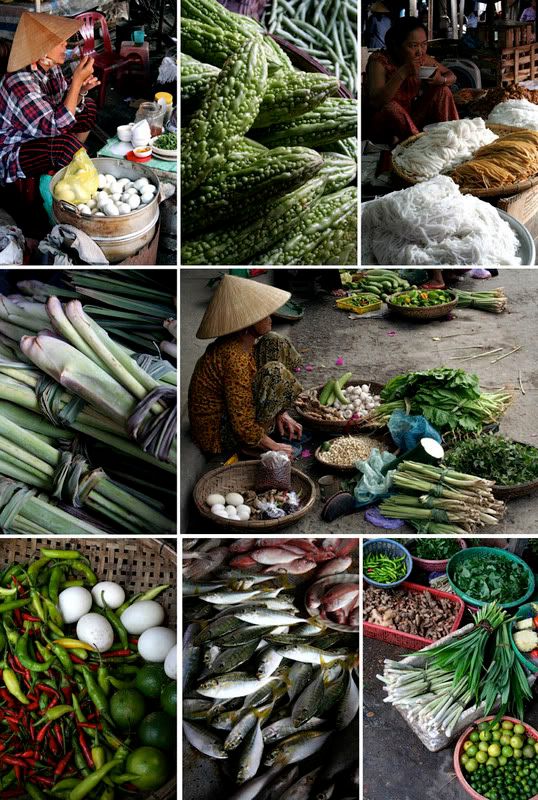 The ground leading inside is a mountainous landscape of herb and vegetable peaks, giving way as you enter to sloping white hills of noodles. Shoppers pause at eight-inch high stools, to sip rich drip coffee or crunch on snacks, like crispy
The ground leading inside is a mountainous landscape of herb and vegetable peaks, giving way as you enter to sloping white hills of noodles. Shoppers pause at eight-inch high stools, to sip rich drip coffee or crunch on snacks, like crispy 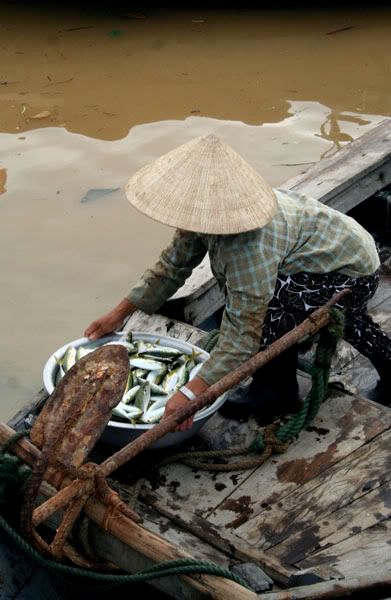
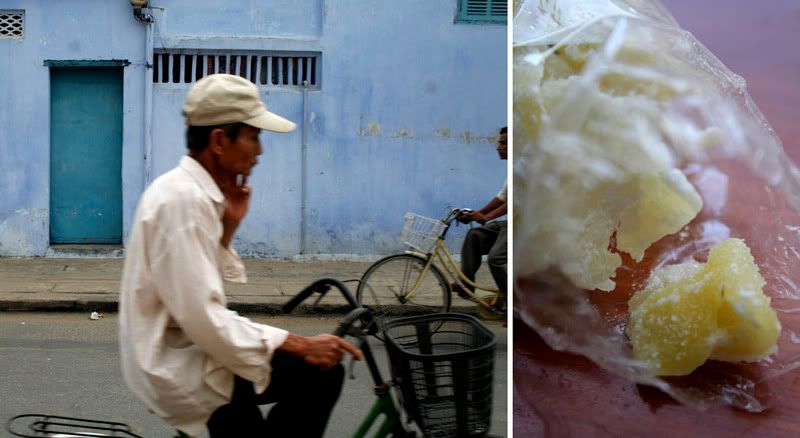 It's undoubtedly very touristy, but I love the sugared ginger sold by street-vendors in Hoi An. It's crunchy/stringy texture and sharp flavor make it the perfect snack after a mellow meal or during a stroll through the market.
It's undoubtedly very touristy, but I love the sugared ginger sold by street-vendors in Hoi An. It's crunchy/stringy texture and sharp flavor make it the perfect snack after a mellow meal or during a stroll through the market.
 I think this is the longest I've been quiet since I started PrimitiveCulture (hopefully I've still got one or two readers checking in), but I'll try to start posting regularly again. At the moment I'm at the Ho Chi Minh City airport, preparing to return to Thailand. The past month here has been incredible, and though we've been busy working, Bordeaux and I had a great time traveling from Hoi An to Phu Quoc via Saigon. Even though we covered a bit more of the country, I still feel as though I barely know it-- but as always, I got enough of a taste to make me want to come back for much longer some day.
I think this is the longest I've been quiet since I started PrimitiveCulture (hopefully I've still got one or two readers checking in), but I'll try to start posting regularly again. At the moment I'm at the Ho Chi Minh City airport, preparing to return to Thailand. The past month here has been incredible, and though we've been busy working, Bordeaux and I had a great time traveling from Hoi An to Phu Quoc via Saigon. Even though we covered a bit more of the country, I still feel as though I barely know it-- but as always, I got enough of a taste to make me want to come back for much longer some day. Back in March, when Bordeaux and I went to Hanoi, we briefly considered taking the long train trip down to Hoi An. Thankfully, we stuck around Hanoi-- at the time, we of course didn't know that we would get to return to Vietnam, and have the chance to spend almost a week in Hoi An. While doing a little online research in Hoi An back then, I encountered the Red Bridge Cooking Class. It sounded great- a chance to cook some local Hoi An dishes in an attractive riverside setting. I bookmarked the page, setting aside just in case.
Back in March, when Bordeaux and I went to Hanoi, we briefly considered taking the long train trip down to Hoi An. Thankfully, we stuck around Hanoi-- at the time, we of course didn't know that we would get to return to Vietnam, and have the chance to spend almost a week in Hoi An. While doing a little online research in Hoi An back then, I encountered the Red Bridge Cooking Class. It sounded great- a chance to cook some local Hoi An dishes in an attractive riverside setting. I bookmarked the page, setting aside just in case. We met the other students at the Hai Cafe, in Hoi An's old town. There, we got the first sign of a major difference between other cooking classes we'd taken-- the number of students was much larger. As we waited for the class to depart, more and more people came, and the class quickly grew to around 20 people- massive, compared to the five person average we'd had at other cooking classes. Thankfully, multiple guides appeared, and we broke up into small six-person groups.
We met the other students at the Hai Cafe, in Hoi An's old town. There, we got the first sign of a major difference between other cooking classes we'd taken-- the number of students was much larger. As we waited for the class to depart, more and more people came, and the class quickly grew to around 20 people- massive, compared to the five person average we'd had at other cooking classes. Thankfully, multiple guides appeared, and we broke up into small six-person groups. She dropped us at the pier, where we boarded the boat to the cooking school. The trip was a definite highlight- a twenty minute float down the muddy river, past fishing traps and under arching palm leavess. Along the way, an old woman in a canoe, smiling between chomps of betel-nut, motioned our boat over. When we got close, she lassoed us, and hitched a lift off us.
She dropped us at the pier, where we boarded the boat to the cooking school. The trip was a definite highlight- a twenty minute float down the muddy river, past fishing traps and under arching palm leavess. Along the way, an old woman in a canoe, smiling between chomps of betel-nut, motioned our boat over. When we got close, she lassoed us, and hitched a lift off us. We arrived at Red Bridge Restaurant, easily the most attractive setting for any cooking class we'd taken. Set right on the river, the kitchen was surrounded by lush tropical greenery, and decorated with bamboo blinds and white silk lanterns. After a quick tour of the herb gardens, our guides wished us a good class, and departed-- and we were left to merge the mini groups into one massive class.
We arrived at Red Bridge Restaurant, easily the most attractive setting for any cooking class we'd taken. Set right on the river, the kitchen was surrounded by lush tropical greenery, and decorated with bamboo blinds and white silk lanterns. After a quick tour of the herb gardens, our guides wished us a good class, and departed-- and we were left to merge the mini groups into one massive class. Having spent about an hour watching a cooking demonstration, and maybe fifteen minutes actually cooking, we were lead to the dining room for a late lunch. The lunch, at least, was fantastic. The seafood salad was tangy and spicy, the claypot eggplant rich and flavorful (made with, I suspect, more than just a cup of tomato sauce), and an extra dish, steamed ocean fish, was fantastic.
Having spent about an hour watching a cooking demonstration, and maybe fifteen minutes actually cooking, we were lead to the dining room for a late lunch. The lunch, at least, was fantastic. The seafood salad was tangy and spicy, the claypot eggplant rich and flavorful (made with, I suspect, more than just a cup of tomato sauce), and an extra dish, steamed ocean fish, was fantastic.